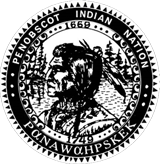Thoreau’s views on Indians
Henry David Thoreau had a lifelong interest in Native American Cultures. As a youth his eyes scanned the ground for small stone fragments left by, what he saw as, vanishing cultures. When Thoreau first visited Indian Island, the home of the Penobscot Nation, he penned the following description: “The ferry here took us past the Indian island. As we left the shore, I observed a short shabby washerwoman-looking Indian; they commonly have the woebegone look of the girl that cried for spilt milk… This picture will do to put before the Indian’s history, that is, the history of his extinction.” Thoreau, like others of his era, believed that Native American culture was on the decline. He was disappointed with what remained of the Penobscot community he witnessed in 1846: “Politics are all the rage with them now. I even thought a row of wigwams, with a dance of pow-wows, and a prisoner tortured at the stake, would be more respectable than this.” In his eyes Penobscot were losing that romantic image of the “noble savage” and exchanging it for politics. His image of the Indian man was not yet realized beyond this stereotypical view.
On Thoreau’s 1846 journey, he aspired to climb Katahdin. He tried to hire Louis Neptune and another man on Mattanawcook Island near Lincoln, but they were unable to get together at the appointed destination. Thoreau described Neptune as “a small, wiry man, with puckered and wrinkled face, yet he seemed the chief man of the two…” Thoreau settled for a couple of non-Native American woodsmen to guide him up the West Branch of the Penobscot River. He later wrote, “We were lucky to have exchanged our Indians, whom we did not know, for these men, who… were reputed the best boat men on the river… and the Indian is said not to be so skillful in the management of the bateau. He is, for the most part, less to be relied on, and more disposed to sulks and whims.” It was not until his next trip that Thoreau actually had more than a conversation with a Penobscot Indian and a better understanding of Penobscots.
On the second journey Thoreau hired the skills of Joseph Attean: “He was a good looking Indian, twenty-four years old, apparently of unmixed blood, short and stout, with a broad face and reddish complexion, and eyes, methinks, narrower and more turned up at the outer corners than ours, answering to the description of his race. Besides his under clothing, he wore a red flannel shirt, woolen pants, and a black Kossuth hat, the ordinary dress of the lumberman, and, to a considerable extent, of the Penobscot Indian.” This description was from the first meeting with Attean at Moosehead Lake. Thoreau did not have a chance to meet Attean on the stagecoach because Attean gave up his seat for ladies, riding in the rain on the outside of the stage. Thoreau’s description of Attean remained largely stereotypical. However, on this trip Thoreau’s overall assumptions of Native American culture was lessened by Attean’s presence. Thoreau needed to look beyond the “Indian” actions to see the truly great Penobscot man.
On Thoreau’s final journey, he hired Joe Polis. It appeared that the more contact Thoreau had with Penobscot Guides, the more he saw them as men and not just “Indians.” Thoreau’s fascination for Native Americans never wavered. In his later years he worked on a comprehensive book about Native Americans. His journeys to the Maine woods with Attean and Polis changed his perceptions of what it meant to be Native American in a rapidly changing world.
One of Thoreau’s biggest contributions to Penobscot history was the documentation of Penobscot place names. These names indicate how Penobscot ancestors saw the landscape. Thoreau once wrote in his journals that “the Indian language reveals another wholly new life to us.” By having contact with two Penobscot men, Thoreau discovered a new, more informed view of Native Americans, moving from his naïve assumption to an understanding that included respect and reverence. Reportedly on his death bed Thoreau’s final words were: “Moose” and “Indian.”
